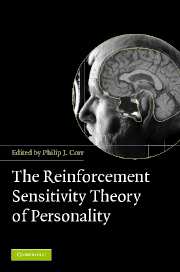Book contents
- Frontmatter
- Contents
- List of abbreviations
- List of figures
- List of tables
- List of contributors
- Preface
- 1 Reinforcement Sensitivity Theory (RST): introduction
- 2 The neuropsychology of fear and anxiety: a foundation for Reinforcement Sensitivity Theory
- 3 Animal cognition and human personality
- 4 The behavioural activation system: challenges and opportunities
- 5 Reinforcement Sensitivity Theory and personality
- 6 Reinforcement sensitivity scales
- 7 Performance and conditioning studies
- 8 Psychophysiological studies
- 9 Reinforcement Sensitivity Theory and mood induction studies
- 10 Neuro-imaging and genetics
- 11 Reinforcement Sensitivity Theory and psychosomatic medicine
- 12 RST and clinical disorders: anxiety and depression
- 13 RST and psychopathy: associations between psychopathy and the behavioral activation and inhibition systems
- 14 Behavioural activation and inhibition in social adjustment
- 15 Reinforcement sensitivity in the workplace: BIS/BAS in business
- 16 Formal and computational models of Reinforcement Sensitivity Theory
- 17 Reinforcement Sensitivity Theory: a critique from cognitive science
- 18 The contribution of Reinforcement Sensitivity Theory to personality theory
- General Index
- Index of Names
- References
8 - Psychophysiological studies
Published online by Cambridge University Press: 31 January 2011
- Frontmatter
- Contents
- List of abbreviations
- List of figures
- List of tables
- List of contributors
- Preface
- 1 Reinforcement Sensitivity Theory (RST): introduction
- 2 The neuropsychology of fear and anxiety: a foundation for Reinforcement Sensitivity Theory
- 3 Animal cognition and human personality
- 4 The behavioural activation system: challenges and opportunities
- 5 Reinforcement Sensitivity Theory and personality
- 6 Reinforcement sensitivity scales
- 7 Performance and conditioning studies
- 8 Psychophysiological studies
- 9 Reinforcement Sensitivity Theory and mood induction studies
- 10 Neuro-imaging and genetics
- 11 Reinforcement Sensitivity Theory and psychosomatic medicine
- 12 RST and clinical disorders: anxiety and depression
- 13 RST and psychopathy: associations between psychopathy and the behavioral activation and inhibition systems
- 14 Behavioural activation and inhibition in social adjustment
- 15 Reinforcement sensitivity in the workplace: BIS/BAS in business
- 16 Formal and computational models of Reinforcement Sensitivity Theory
- 17 Reinforcement Sensitivity Theory: a critique from cognitive science
- 18 The contribution of Reinforcement Sensitivity Theory to personality theory
- General Index
- Index of Names
- References
Summary
The original version of Reinforcement Sensitivity Theory (RST) (Gray 1982, 1987, 1991) postulated three basic emotion systems, identifiable in animal species, with relevance to human personality. The three systems are defined as the Behavioural Approach System (BAS), the Behavioural Inhibition System (BIS) and the Fight-Flight System (FFS). The BAS is thought to be a simple positive feedback system which is sensitive to stimuli associated with reward (approach) or with omission (active avoidance) or termination of punishment (escape). This system is responsible for positive affect. The BAS is involved in moving the organism up to the temporo-spatial gradient through the location of the reward.
The BIS is defined by inhibition of ongoing behavior programs in response to conditioned stimuli associated with punishment or non-reward (frustration), or novel stimuli. The BIS mechanism is thought as a comparator that continuously scans the environment by checking predicted against actual events (checking mode) and being able to stop programmed motor activity by other systems (control mode) if they do not match. The system also modulates the control of exploratory behavior by diverting attention toward the threatening or novel stimulus. When a mismatch between predicted and actual events occurs, the motor program is stopped and outputs of the BIS seek to take more information by enhancing attention and arousal. This system is responsible for negative affect.
- Type
- Chapter
- Information
- The Reinforcement Sensitivity Theory of Personality , pp. 261 - 290Publisher: Cambridge University PressPrint publication year: 2008
References
- 4
- Cited by

